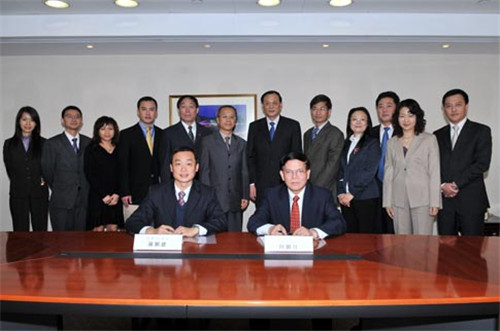
 {{_.$tools.formatDate(item.publishTime, 'yyyy-MM-dd')}} {{item.title}}
{{_.$tools.formatDate(item.publishTime, 'yyyy-MM-dd')}} {{item.title}} 
Macao and mainland China inks new MOU regarding the air transport market between the two places

Macao and mainland China inks new MOU regarding the air transport market between the two places 2009-02-03
The General Administration of Civil Aviation of China (CAAC) and the Civil Aviation Authority of Macao SAR (AACM) signed a new Memorandum of Understanding (MOU) regarding the air transport market between mainland China and Macao on 3 February 2009. The new MOU, which lifted some of the restrictions imposed on airline designation and capacity in the old memorandum, will help to enhance the air transport market between the two places.
With the rapid economic development in mainland China and the opportunities driven by the economic boom in Macao, there are great potentials in the expansion of the air services between the two places. The two aeronautical authorities met in April 2008 in Macao for exchange of opinions about the sustainable growth of the air transport market between mainland China and Macao and reached preliminary conclusions on liberalizing the MOU provisions.
The old MOU was signed in December 2006. According to the old memorandum, the number of mainland destinations opened for operation was 57. The designation of airlines and the capacity provisions had certain restrictions, depending on the destinations. Although the new MOU is still confined to 57 destinations, the restrictions imposed on airline designation and capacity, however, are partially lifted. The main provisions of the two memoranda can be compared in the following table:
Provisions | Old MOU | New MOU |
Destinations | 57* | 57* |
Airline designation | Beijing, Shanghai, Guangzhou, Shenzhen, Chengdu, Kunming and Dalian: 2 passenger-cargo combination airlines and 1 all-cargo airline for each point For the remaining 50 points: 3 passenger-cargo combination airlines and 1 all-cargo airline for each point | Commencing the 2009 summer schedule, for Beijing, Shanghai, and Shenzhen: 3 passenger-cargo combination airlines and 2 all-cargo airline for each point Commencing the 2009 winter schedule, the above number can be increased to 4 passenger-cargo combination airlines and 3 all-cargo airline for each point No restriction on the remaining 54 points |
Passenger and cargo combination capacity | Beijing, Shanghai, Guangzhou, Shenzhen, Chengdu, Kunming and Dalian: a total of 372 flights per week per each direction No restriction on the remaining 50 points | Commencing the 2009 summer schedule, for Beijing, Shanghai and Shenzhen: a total of 253 flights per week per each direction for 3 points Commencing the 2009 winter schedule, the above capacity can be increased to 281 flights per week per each direction No restriction on the remaining 54 points |
All-cargo capacity | Beijing and Shanghai: a total of 49 flights per week per each direction No restriction on the remaining 55 points | Commencing the 2009 summer schedule, for Beijing and Shanghai:a total of 63 flights per week per each direction Commencing the winter schedule, the above capacity can be increased to 77 flights per week per each direction No restriction on the remaining 55 points |
Presently, the mainland destinations for scheduled services which Macao now connects to amounts to 12: Beijing, Chengdu, Fuzhou, Guilin, Kunming, Hangzhou, Nanjing, Shanghai, Xiamen, Wuhan, Tianjin and Wuxi. These services are operated by 6 mainland and Macao airlines which are Air Macau, China Eastern Airlines, East Star Airlines, Shanghai Airlines, Shenzhen Airlines and Xiamen Airlines. The signing ceremony was conducted at the cabinet of the Secretary for Transport and Public Works. With the presence of the Secretary for Transport and Public Works, Mr. Lau Si Io and the Vice Minister of CAAC, Mr. Yang Guoqing as the guests of honour, President of AACM, Mr. Chan Weng Hong and Vice Director of the Air Transport Bureau of CAAC, Mr. He Jinri signed the new MOU.
Secretary Lau Si Io and Vice Minister Yang Guoqing had a meeting before the signing ceremony. Secretary Lau thanked the Central Government for its long-term support rendered to Macao’s aviation and explained how the SAR government has helped the local aviation industry and the local airlines to develop their business by adopting flexible measures. In addition, Secretary Lau raised the following issues to CAAC for their study and consideration: allowing the mainland airlines to fly beyond points via Macao, allowing Macao’s airlines to fly to beyond points via mainland cities and allowing foreign airlines to fly to mainland cities via Macao. Facing the realization of cross strait direct flights, Secretary Lau also wished that the market between Macao and Taiwan can be opened up, for example, more destinations in Taiwan and more Taiwanese airlines to be allowed to fly between the two places. Vice Minister Yang indicated that the Central Government will continue to render support to the development of Macao’s aviation and will study deeply into the issues requested by the Macao side. Both sides agreed that the aeronautical authorities of Macao and mainland China should meet regularly to continually discuss and exchange opinions and establish cooperation regarding the enhancement of the air transport market between mainland China and Macao.
*The 57 mainland cities opened for operation are as follows:
Beijing, Shanghai, Guangzhou, Kunming, Dalian, Chengdu, Tianjin, Hangzhou, Xiamen, Fuzhou, Xian, Chongqing, Qingdao, Urumqi, Nanjing, Guilin, Changsha, Wuhan, Ningbo, Shantou, Haikou, Shenyang, Shijiazhuang, Changchun, Harbin, Taiyuan, Sanya, Huangshan, Wenzhou, Zhengzhou, Jinan, Lijiang, Hefei, Nanchang, Luoyang, Yantai, Beihai, Wuyishan, Meixian, Zhanjiang, Lanzhou, Nanning, Guiyang, Zhangjiajie, Hailar, Yanji, Jiamusi, Qiqihar, Mudanjiang, Weihai, Xishuangbanna, Lhasa, Kashi, Yinchuan, Yichang and Hohhot.

Under the witness of Secretary for Transport and Public Works, Mr. Lao Si Io and the Vice Minister of the General Administration of Civil Aviation of China, Mr. Yang Guoqing, the aeronautical authorities of Macao and mainland China signed a new Memorandum of Understanding regarding a more liberal air transport market between the two places
























